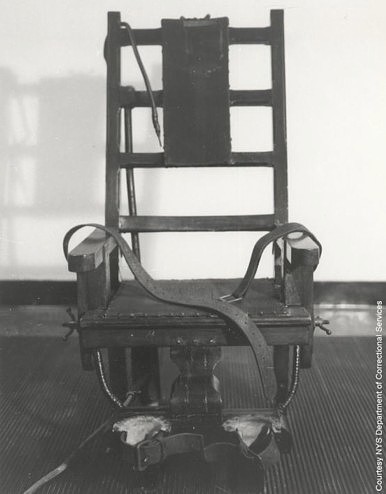Edison's publicity campaign:
Edison carried out a campaign to discourage the use[11] of alternating current, including spreading information on fatal AC accidents, publicly killing animals, and lobbying against the use of AC in state legislatures. Edison directed his technicians, primarily Arthur Kennelly and Harold P. Brown,[12] to preside over several AC-driven executions of animals, primarily stray cats and dogs but also unwanted cattle and horses. Acting on these directives, they were to demonstrate to the press that alternating current was more dangerous than Edison's system of direct current.[13] Edison's series of animal executions peaked with the filmed electrocution of Topsy, a Coney Island circus elephant. He also tried to popularize the term for being electrocuted as being "Westinghoused".
Edison opposed capital punishment, but his desire to disparage the system of alternating current led to the invention of the electric chair. Harold P. Brown, who was at this time being secretly paid by Edison, constructed the first electric chair for the state of New York in order to promote the idea that alternating current was deadlier than DC.[14]
When the chair was first used, on August 6, 1890, the technicians on hand misjudged the voltage needed to kill the condemned prisoner, William Kemmler. The first jolt of electricity was not enough to kill Kemmler, and only left him badly injured. The procedure had to be repeated and a reporter on hand described it as "an awful spectacle, far worse than hanging." George Westinghouse commented: "They would have done better using an axe." |
Elektrische stoel:
De fameuze elektrische stoel - Old Sparky van Sing-Sing Gevangenis
De strijd bereikte een absurd hoogtepunt in 1887 toen een groep afgevaardigden van de staat New York aan Edison vroeg of elektriciteit gebruikt kon worden als executiemethode. Hoewel Edison hier eerst niets van wilde weten, gaf hij toch toe. Met één kanttekening: "Dan moet je wel de stroom van mijn concurrent gebruiken, want die is veel dodelijker". Edison hoopte hiermee Westinghouse uit te schakelen door wisselstroom te associëren met de dood.
Een door Edison ingehuurde ingenieur, Harold P. Brown, voerde vervolgens publieke demonstraties uit. Zwerfhonden, katten, paarden en zelfs een circusolifant werden opgeofferd om aan te tonen hoe dodelijk wisselstroom was. De staat New York raakte overtuigd en besloot de executiemethode te gebruiken.
Hoewel Westinghouse weigerde hieraan mee te werken, wist Brown toch via een list een wisselstroomdynamo bij Westinghouse te bestellen. Op 6 augustus 1890 werd de moordenaar William Kemmler de eerste persoon die veroordeeld werd tot de elektrische stoel. De beste advocaat werd door Westinghouse ingehuurd om hem ter verdedigen en deze noemde elektrocutie een "wrede en onmenselijke straf", iets dat verboden is onder het achtste amendement van de grondwet van de Verenigde Staten.
De executie was een drama, omdat Kemmler pas in tweede instantie stierf. Westinghouses antwoord hierop was: "Ze hadden beter een bijl kunnen gebruiken". Desondanks werd de elektrische stoel in veel Amerikaanse staten ingevoerd.
|

